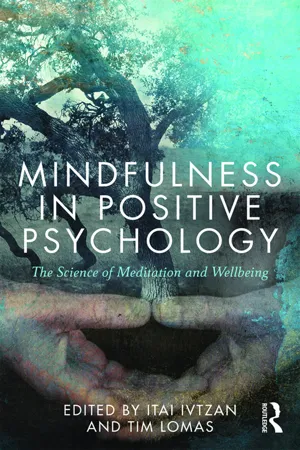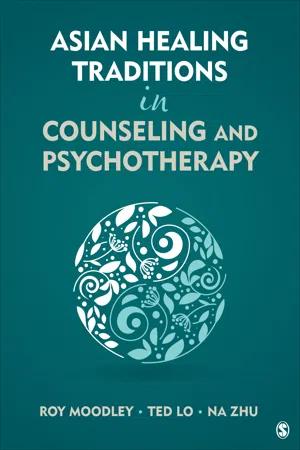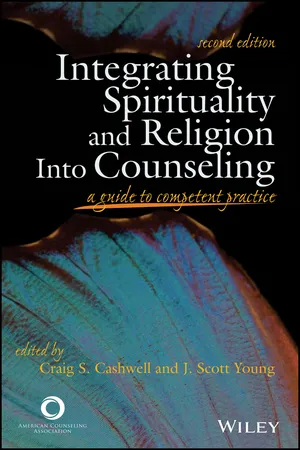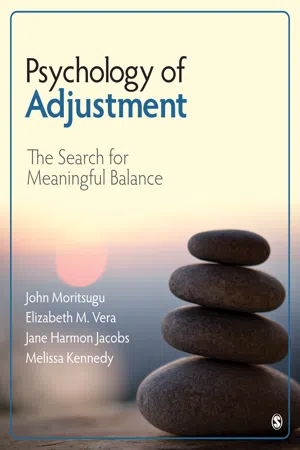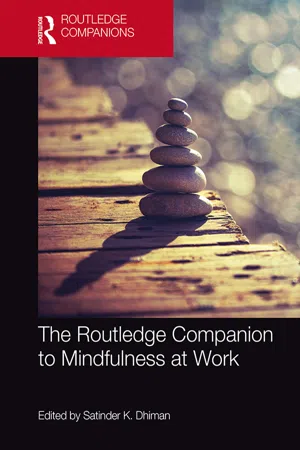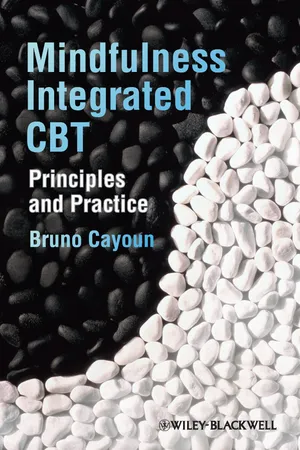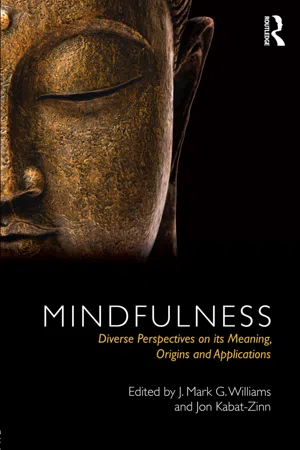Psychology
Mindfulness Psychology
Mindfulness psychology involves the practice of being fully present and engaged in the current moment, without judgment. It emphasizes self-awareness, attention to thoughts and feelings, and the cultivation of a non-reactive mindset. This approach has been shown to have positive effects on mental well-being, stress reduction, and overall psychological health.
Written by Perlego with AI-assistance
Related key terms
10 Key excerpts on "Mindfulness Psychology"
- eBook - ePub
Mindfulness in Positive Psychology
The Science of Meditation and Wellbeing
- Itai Ivtzan, Tim Lomas(Authors)
- 2016(Publication Date)
- Routledge(Publisher)
Mindfulness is perceived as a form of awareness that arises from attending to the present moment in a non-judgemental and accepting manner (Bishop et al., 2004). This invites the practitioner to attend to the full range of internal and external experiences in this non-judgemental attitude (Hart, Ivtzan, & Hart, 2013). Research has indicated that mindfulness enhances both hedonic (Brown & Cordon, 2009) and eudaimonic wellbeing (Brown, Ryan, & Creswell, 2007), which are both at the heart of positive psychology research and application. Hedonic wellbeing is linked with pain relief and intensified pleasure (Deci & Ryan, 2008), and eudaimonic wellbeing involves living a meaningful, self-realised and fully functional life (Ryff & Keyes, 1995). The concept of mindfulness originates in traditional Buddhist contemplative practices, where the development of psychological wellbeing is regarded as a primary goal (Shapiro, 2009). Buddhist mindfulness practitioners aspire to improve positive psychological experiences including joy, awareness and compassion. Within its original religious context, mindfulness is a fundamental part of a broad program of psycho-spiritual development, aiming to help people reach ‘enlightenment’. Although terms such as ‘enlightenment’ are difficult to rationalise within the ontological and epistemological contexts of Western psychology, it may be conceived of as the superlative state of happiness, equanimity and freedom that a human being is capable of experiencing. However, with the transference to Western psychology, the term mindfulness has been interpreted in a way that made it lose some of its initial potential as a means of psycho-spiritual transformation. And although it has been investigated for over 40 years in the West, some of its beneficial objectives have been disregarded - Roy Moodley, Ted Lo, Na Zhu(Authors)
- 2017(Publication Date)
- SAGE Publications, Inc(Publisher)
9 Integrating Mindfulness, Meditation, Buddhism, and Therapeutic Practices Marco MascarinIn the contemporary North American lexicon, mindful is often used as a descriptive prefix to any number of activities: mindful investing, mindful parenting, and mindful eating, to name a few. As a clinical term, mindfulness can describe evidence-based psychotherapeutic interventions, such as mindfulness-based stress reduction (MBSR) or mindfulness-based cognitive therapy (MBCT). As a 2,500-year-old Asian contemplative practice, mindfulness meditation is an integral component of the Buddhist path that promises liberation from existential suffering.Over the past few decades, the secular and clinical applications of mindfulness have generated enormous and ever-growing interest. Mindfulness has been the subject of thousands of research papers; empirical measurement scales with associated psychometric studies; courses at universities; and programs in hospitals, prisons, and a variety of educational institutions. In a 2004 paper titled “Mindfulness: A Proposed Operational Definition,” Bishop and colleagues described “the results of recent meetings held to establish a consensus on mindfulness and to conjointly develop a testable operational definition” (p. 230).1 Bishop and his colleagues referred to earlier research, which broadly conceptualized mindfulness as “a kind of non-elaborative, non-judgmental, present-centered awareness in which each thought, feeling or sensation that arises in the attentional field is acknowledged and accepted as it is” (p. 232).2 The authors then offered a number of operational definitions of mindfulness, one of them being as follows:We see mindfulness as a process of regulating attention to bring a quality of non-elaborative awareness to current experience and a quality of relating to one’s experience within an orientation of curiosity, experiential openness and acceptance. (p. 234)3- eBook - ePub
Essential Oils for Mindfulness and Meditation
Relax, Replenish, and Rejuvenate
- Heather Dawn Godfrey(Author)
- 2018(Publication Date)
- Healing Arts Press(Publisher)
1 What Is Mindfulness? Why and How to Make It Part of Your LifeMindfulness is a state of consciously being aware, of paying attention to and maintaining concentration on and consciousness of the here and now. It is being in the present moment, noticing what is happening internally and externally without pre-judgment, condition, or expectation, but with gentle acceptance, unconditional intentionality, and equanimity (calmness of temper, composure). In Mindfulness and Mental Health, a cogent summary of the field, author and psychotherapist Chris Mace clarifies:Mindfulness is a way of being aware—mindful awareness is receptive not exclusive. Sensations, thoughts or feelings are simply experienced for what they are. To be mindfully aware means, strangely, there can be no “mind.” Even if thoughts are chattering away, they receive no more attention than anything else that has arisen. As people's ordinary, reactive ways of restricting their awareness diminishes, a sense of the suchness of things emerges.1An aspect of insight meditation, mindfulness evolved from Buddhism and was introduced to the West during the 1970s. Although steeped in Buddhist philosophy, the simplicity of its processes and practice enables its presentation in nonreligious, independent contexts as an aid to focus attention on the here and now: conscious, present-centered awareness amidst the rhythm of daily life. In hospitals and in clinical practice, mindfulness has demonstrated some success in alleviating the experience of depression, anxiety, post-traumatic stress disorder, stress, and stress-related conditions, so it is often recommended as a supportive self-help technique. It has also been included in management of chronic pain. - eBook - ePub
Neuroscience and Psychology of Meditation in Everyday Life
Searching for the Essence of Mind
- Dusana Dorjee(Author)
- 2017(Publication Date)
- Routledge(Publisher)
MindfulnessMindfulness practice has been popularized over the last three decades in the secular healthcare context as a method of improving health and well-being. There are various conceptualizations of mindfulness in both secular and traditional Buddhist contexts and also marked differences between some of them. In this chapter we will explore some of these approaches to mindfulness and consider their implications for applications and research on the effects of mindfulness in everyday life. We will start by discussing various definitions of mindfulness and approaches to cultivating mindfulness. Then we will turn to neuroscientific evidence regarding the effects of mindfulness on brain function and structure. We will also discuss the possible role of mindfulness in our health and well-being from the perspective of the framework outlined in the first chapter – in terms of self-regulation and existential well-being. Finally, we will explore how mindfulness could be cultivated in everyday life, both in formal and informal practice.What is mindfulness?
There is no consensus on definitions of mindfulness, with various accounts presented both in secular and Buddhist contexts (Williams and Kabat-Zinn, 2013). However, there are some most commonly applied definitions which we will explore now. In mindfulness-based approaches (MBSR and MBCT) mindfulness is frequently defined as an awareness arising by purposefully paying attention in the present moment with an attitude of non-reactivity, non-judgement and openness (Kabat-Zinn, 2003; Kabat-Zinn, 2013). This definition is based on foundational work of Jon Kabat-Zinn who, together with his colleagues, developed the MBSR course in 1970s as a means to support patients with chronic health problems. The MBCT followed and was largely based on MBSR combined with elements of cognitive behavioural therapy (Teasdale et al., 2000). The MBCT was developed as a treatment particularly intended for recurrent depression (Teasdale, Segal and Williams, 1995) whereas MBSR had from the start a broader client focus in both treatment and prevention of illness. - No longer available |Learn more
Integrating Spirituality and Religion Into Counseling
A Guide to Competent Practice
- Craig S. Cashwell, J. Scott Young(Authors)
- 2014(Publication Date)
- American Counseling Association(Publisher)
Attention is focused awareness; whereas awareness is like the background scanner, attention is a focusing in on certain details that arise in the field of awareness (Brown & Ryan, 2004). The ability to hold sustained and focused attention is a core component of mindfulness practice. It involves an inhibition of secondary processing of events—the mental chatter and elaborative thinking that often surrounds experience. The practice itself cultivates this capacity.Present Moment
Mindfulness practice is about being fully in the moment. Mindfulness practice is about observing what is happening now, whether that is an external activity, a mental activity, or the arising of distraction. Mindfulness in everyday life is similar to the experience of flow described by Csikszentmihalyi (1991). When people are engaged in a task that produces a state of flow, they are fully immersed in the activity at hand—focused, alert, creative, and joyful.Attitude of Acceptance
The essence of mindfulness is an attitude of acceptance of all of experience. It is what distinguishes mindful attention from ordinary, everyday attention. For instance, attention could be harsh and critical, or it could be open and accepting. It is easy to imagine a client bringing highly focused yet critical attention to an issue of concern, which could lead to avoidance of the problem out of fear, suppression, dissociation from thoughts and feelings, or rumination about the problem. The mindfulness practitioner observes all experiences as a scientist would observe an object under the microscope—with open, accepting curiosity (Gunaratana, 2002). This ability to stand as an impartial witness to experience is what allows the individual to stay present with what is happening, even if that moment is uncomfortable or unwanted, rather than reacting to it in habitual ways (e.g., withdrawing, pushing away, lashing out). It also serves as a type of exposure therapy. Much of people’s automatic pilot reactions stem from meta-cognitions about their experience. For example, say one feels sad that one is sad or anxious about being anxious. By staying with the first-level emotion, the mindfulness practitioner begins to see that anxiety is not so bad. As Bien (2006) stated, “Mindfulness is a way to overcome emotional indigestion. By allowing our awareness to flow freely and openly with our experience, we gradually digest these difficult experiences and feelings” (p. 72). - eBook - ePub
Psychology of Adjustment
The Search for Meaningful Balance
- John N. Moritsugu, Elizabeth M. Vera, Jane K. Harmon Jacobs, Melissa J. Kennedy(Authors)
- 2016(Publication Date)
- SAGE Publications, Inc(Publisher)
mindfulness meditation, an openness to all aspects of the present experience can develop. Mindfulness meditation can be described as specific meditation practices that cultivate awareness through the focus of attention on the basic fundamentals of experience: breath, sensations (i.e., sight, sound, smell, taste), emotions, and thoughts. This openness to experience includes awareness of what is going on around us, along with awareness of thoughts, feelings, and physical sensations. The practice of meditation allows us to live more fully in the present moment.Meditation practices refer to the disciplined practices that are thought to promote the development of increased mindfulness in daily life. While different types of meditation practices have found their way into the mainstream culture and the psychological literature, the most frequent term that currently describes the use of meditation is mindfulness-based practices. Mindfulness-based practices and their application to physical and psychological health deserve attention as potential contributors to the topics and themes of this book. During the past four decades, a proliferation of scientific research on mindfulness-based practices has emerged, which addresses physical and mental health issues and promotes health and wellness (Sedlmeier et al., 2012). Contributions from research on mindfulness in psychology, medicine, and neuroscience inform the application of mindfulness to the theme of the search for meaningful balance. We provide one example of this in the Adjustment in Practice: Meditation Exercise .ADJUSTMENT IN PRACTICE Meditation Exercise
Sitting meditation: Bringing the breath into focus Find a quiet, comfortable place where you will be undistracted for 10 minutes. It is helpful to have a clock or gentle alarm to remind you when 10 minutes is complete. Sit in a chair, with both feet on the ground, back straight, arms resting comfortably at your side, hands resting on your lap. Close your eyes or, if you prefer, focus your eyes on a point about 3 feet in the distance. Become aware of your breathing, and begin to focus on a point where you notice your breath when you exhale. People generally focus on the tip of the nostrils or on their abdomen.You may notice that your mind frequently wanders. As soon as you become aware of your mind wandering, bring your attention back to the point you have chosen to observe your exhalation—your nostrils or your abdomen. Each time you notice your thoughts, bring your attention back to your point of exhalation. - eBook - ePub
- Satinder K. Dhiman(Author)
- 2020(Publication Date)
- Routledge(Publisher)
Mindfulness has only recently become a highly studied variable amongst social science scholars; however, the concept has been around for millennia. Mindfulness dates back thousands of years; it is mostly rooted in Buddhist psychology but also shares ideas from other traditions, such as some of the ancient Greek philosophers (Brown, Ryan, & Creswell, 2007; Dane, 2011). Dane (2011) carried out an overview of recent academic conceptualizations of mindfulness and argued that for a long time, it was associated primarily with Eastern traditions and dismissed by scientists as too “Zen-like,” perhaps because it was incorrectly associated with meditation (p. 998).However, more recently scholars have concluded mindfulness and related practices of Eastern traditions, such as meditation, are not necessarily interchangeable and that mindfulness can indeed be scientifically studied apart from its more “Zen” origins (Dane, 2011). Dane (2011) adds that there have recently been many different perspectives on, and conceptualizations of, the term, many of them focusing on three common features: mindfulness as a state of consciousness, mindfulness as a focus on present phenomena (e.g., Brown & Ryan, 2003), and third, mindfulness as a process involving both internal and external phenomena. Combining all three elements, Dane proposed the following definition: mindfulness is a “state of consciousness in which attention is focused on present-moment phenomena occurring both externally and internally” (2011, p. 1000).Similarly, Long and Christian have (2015) defined mindfulness as a “psychological construct associated with nonjudgmental attention and awareness of present-moment experiences” (p. 1409). Mindfulness reflects the state when we become so aware of our thought processes that we become open to novel perspectives (Gudykunst, 1993; Langer, 1989). Being mindful is being able to focus only on specific chosen things or events in the present moment, and not consider the past, the future, or other distractions. Previous literature has also focused on the nature of mindfulness, such as how the variable can be operationalized.Shapiro, Carlson, Astin, and Freedman (2006), for instance, posited three axioms/components of mindfulness—intention, attention, and attitude—and argued these are “interwoven aspects of single cyclic process and occur simultaneously” as mechanisms of the mindfulness process (p. 375). Baer, Smith, Hopkins, Krietemeyer, and Toney (2006) also argued for five multiple dimensions of mindfulness; Taylor and Millear (2016) describe these multiple dimensions, or attributes, as: (1) observing the immediate/present external environment, (2) describing said environment with words, (3) acting based on awareness of that environment, (4) not assessing/judging the environment in any way, and (5) not reacting before thinking in regards to that environment. Finally, mindfulness has been described as both a state , for example a state achieved during meditation, and a trait - eBook - ePub
Learned Mindfulness
Physician Engagement and M.D. Wellness
- Frank John Ninivaggi(Author)
- 2019(Publication Date)
- Academic Press(Publisher)
The effectiveness of meditative techniques led to modifications of protocols and using mindfulness practices for stress reduction. Reducing distressing rumination and worry over life's puzzling challenges was a significant enhancement. Gradually, the connections with Yoga and Buddhism led to various integrations, too many to detail in this brief review. Bringing into consideration compassion for self and others was another refreshing insight. Mindfulness practices enhance one's sense of concern for suffering and evoke the desire to help. The benefits of becoming mindful, however, include stress reduction and reduced anxiety with mood stability. Greater mental clarity and focus are by-products sought. Mindfulness practice develops more significant self-knowledge and understanding. Behavior change, reduced anxiety, and adaptive coping strategies are parts of this.2.4. Mindfulness: Foundational Perspectives
Western thinking tends toward scientific, logical, organized, and rational approaches focusing on what is conscious and testable. While reasonable, a few classicists see it at odds with the sources from which mindfulness practices arose. A realistic position approaches mindfulness using its evidenced-informed and scientifically researched mechanisms.Distinctions, therefore, among mindfulness, mindfulness meditation, and meditation clarify nuances. Most recognize mindfulness as a state of awareness that is (1) attentively single, (2) clear, and (3) emotionally poised. To achieve mindfulness, practitioners use mindfulness exercises. These procedures have several terms, each having nuanced emphases. The phrase “meditation practices” is used; less often, “meditation.” This book prefers the more psychologically oriented term “mindfulness” and “pause” to cover both the mindfulness systems and their attainment.The culturally oriented roots of mindfulness cannot be dismissed without losing something of the heart and soul of any practice. Western methods have tried to westernize mindfulness practices by minimizing these references—mostly, although there are exceptions. For example, David R. Vago PhD, a distinguished cognitive neuroscientist, has contributed seminal work on mapping modalities of self-awareness in mindfulness practice. Attempts to capture a definition of self-processing loom large but remain elusive.Self-processing typically entails attempts to make sense of perceptual images and mental concepts of oneself. His research offers much in the understanding of self-processing (Vago, 2013 , 2014 ). Northoff (2011) also explains the self-processing theory as have Brewer, Garrison, and Whitfield-Gabrieli (2013) , Brewer and Garrison (2013) , Brewer, Davis, and Goldstein (2013) . While adhering to Buddhist fundamentals, Vago uses Western scientific models to integrate his knowledge of mindfulness mechanisms as a triune of self-awareness, self-regulation, and self-transcendence. Vago and Silbersweig (2012) - eBook - ePub
Mindfulness-integrated CBT
Principles and Practice
- Bruno A. Cayoun(Author)
- 2011(Publication Date)
- Wiley-Blackwell(Publisher)
Part I: Theoretical Foundation Chapter 1 Operationalization of MindfulnessTherapeutic progress depends upon awareness; in fact the attempt to become more conscious is the therapy. Edward WhitmontDefinition of MiCBTAs a mental state, mindfulness is experienced as a heightened sensory awareness of the present moment, free from judgment, reactivity and identification to the experience. As a training, mindfulness requires deliberate sustained attentional focus on sensory processes with unconditional acceptance of the sensory experience. Mindfulness-integrated Cognitive Behavior Therapy (MiCBT) is a systemic therapy approach that integrates mindfulness meditation with core elements of cognitive and behavioral methods for the purpose of teaching clients to internalize attention in order to regulate emotion and attention, and externalize these skills to the contexts in which their impairment is triggered or maintained.The 4-Stage Model of delivery This integration can be applied flexibly within a 4-stage model. Personal StageIn stage 1, Mindfulness meditation training is taught to internalize attention in a way that promotes deep levels of experiential awareness and acceptance. The emphasis is on the internal context of experience to equip clients with an increased sense of self-control and self-efficacy in handling thoughts and emotions before addressing daily stressors. We learn to regulate attention and emotions.Exposure StageStage 2 is the first externalizing stage. It introduces various exposure procedures, first in imagery and then in vivo , to decrease avoidance and increase self-confidence. We learn to decrease reactivity to external situations.Interpersonal StageStage 3 requires externalizing attention further towards others by decentering attention from self to others. It includes mindfulness-based interpersonal skills to understand experientially others’ ways of communicating, combined with assertiveness and other social skills training to address the interpersonal context of psychological difficulties and help prevent relapse. We learn to prevent our reaction to others’ reactivity. - eBook - ePub
Mindfulness
Diverse Perspectives on its Meaning, Origins and Applications
- J. Mark G. Williams, Jon Kabat-Zinn(Authors)
- 2013(Publication Date)
- Routledge(Publisher)
Rupert Gethin revisits some traditional Buddhist sources to see how they understand mindfulness, exploring how their understanding fits—or does not—with some of the ways mindfulness is now presented in the context of mind-fulness-based interventions. Starting with well-known sources such as the Sati-pat.t.hanasutta, he moves on to pay more attention to some of the details of the understanding of mindfulness in later Buddhist systematic thought. These details, though less well known, provide important clues about traditional Buddhist approaches to the cultivation of mindfulness. In particular, he explores the notion of mindfulness as ‘non-judgmental’. He very cogently maps out the full range of the territory and potential issues at the interface of the converging epistemological streams:How one views the adaptation of Buddhist mindfulness practice to a modern clinical context for the treatment of stress and depression will depend on one's particular perspective. From one sort of Buddhist perspective, the abstraction of mindfulness from its context within a broad range of Buddhist meditative practices might seem like an appropriation and distortion of traditional Buddhism that loses sight of the Buddhist goal of rooting out greed, hatred and delusion. From a different Buddhist perspective, it might seem to be an example of ‘skill in means’ (upāya-kauśalya): it provides a way of giving beings the opportunity to make a first and important initial step on the path that leads to the cessation of suffering. From yet another perhaps still Buddhist perspective that might be characterized as ‘modernist’, it strips Buddhism of some of its unnecessary historical and cultural baggage, focusing on what is essential and useful. A non-Buddhist perspective might regard the removal of the unnecessary historical and cultural baggage as finally revealing the useful essence that had hitherto been obscured by the Buddhist religion. Finally we might regard the coming together of practices derived from Buddhism with the methods of modern western cognitive science as affording a true advance that supersedes and renders redundant the traditional Buddhist practices. As observers of social history, we might also see it as an example of a change from a cultural situation where we turn to religion to heal our souls to one where we turn to medicine and science.
Index pages curate the most relevant extracts from our library of academic textbooks. They’ve been created using an in-house natural language model (NLM), each adding context and meaning to key research topics.
